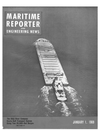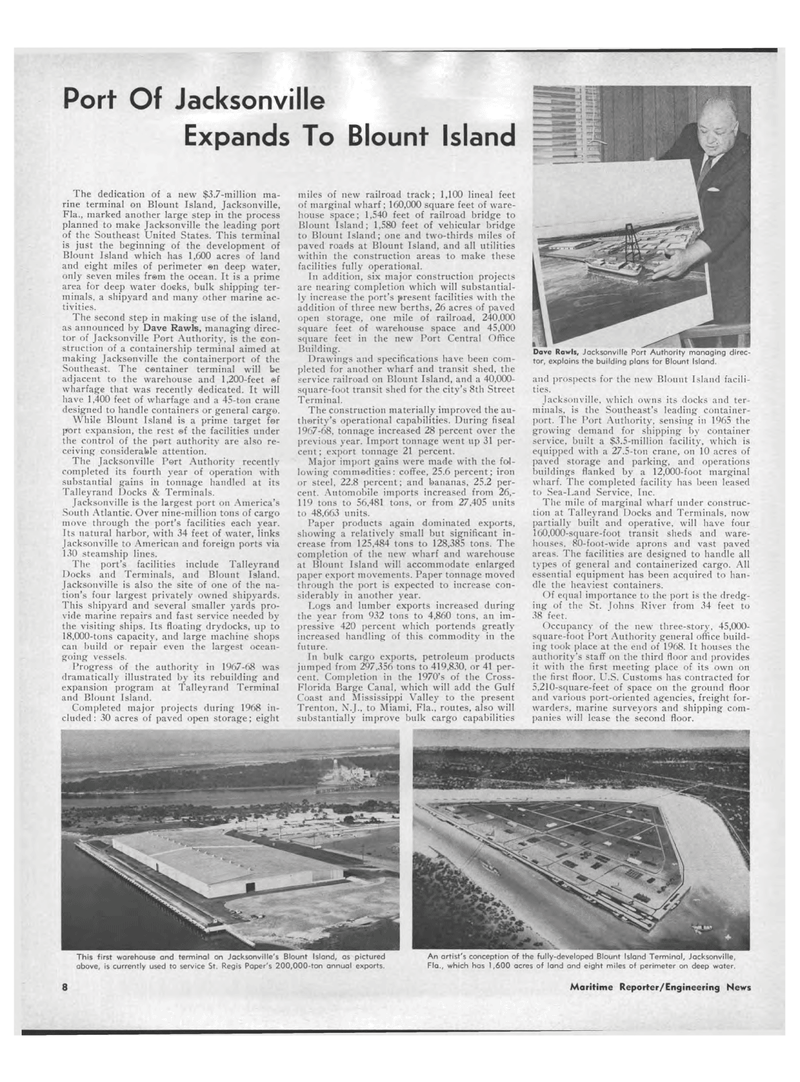
Page 10: of Maritime Reporter Magazine (January 1969)
Read this page in Pdf, Flash or Html5 edition of January 1969 Maritime Reporter Magazine
Port Of Jacksonville Expands To Blount Island This first warehouse and terminal on Jacksonville's Blount Island, as pictured An artist's conception of the fully-developed Blount Island Terminal, Jacksonville, above, is currently used to service St. Regis Paper's 200,000-ton annual exports. Fla., which has 1,600 acres of land and eight miles of perimeter on deep water. The dedication of a new $3.7-million ma-rine terminal on Blount Island, Jacksonville, Fla., marked another large step in the process planned to make Jacksonville the leading port of the Southeast United States. This terminal is just the beginning of the development of Blount Island which has 1,600 acres of land and eight miles of perimeter ©n deep water, only seven miles from the ocean. It is a prime area for deep water docks, bulk shipping ter-minals, a shipyard and many other marine ac-tivities. The second step in making use of the island, as announced by Dave Rawls, managing direc-tor of Jacksonville Port Authority, is the con-struction of a containership terminal aimed at making Jacksonville the containerport of the Southeast. The csntainer terminal will be adjacent to the warehouse and 1,200-feet ®f wharfage that was recently dedicated. It will have 1,400 feet of wharfage and a 45-ton crane designed to handle containers or general cargo. While Blount Island is a prime target for port expansion, the rest of the facilities under the control of the pert authority are also re-ceiving considerable attention. The Jacksonville Port Authority recently completed its fourth year of operation with substantial gains in tonnage handled at its Talleyrand Docks & Terminals. Jacksonville is the largest port on America's South Atlantic. Over nine-million tons of cargo move through the port's facilities each year. Its natural harbor, with 34 feet of water, links Jacksonville to American and foreign ports via 130 steamship lines. The port's facilities include Talleyrand Docks and Terminals, and Blount Island. Jacksonville is also the site of one of the na-tion's four largest privately owned shipyards. This shipyard and several smaller yards pro-vide marine repairs and fast service needed by the visiting ships. Its floating drydocks, up to 18.000-tons capacity, and large machine shops can build or repair even the largest ocean-going vessels. Progress of the authority in 1967-68 was dramatically illustrated by its rebuilding and expansion program at Talleyrand Terminal and Blount Island. Completed major projects during 1968 in-cluded : 30 acres of paved open storage; eight miles of new railroad track; 1,100 lineal feet of marginal wharf; 160,000 square feet of ware-house space; 1,540 feet of railroad bridge to Blount Island; 1,580 feet of vehicular bridge to Blount Island; one and two-thirds miles of paved roads at Blount Island, and all utilities within the construction areas to make these facilities fully operational. In addition, six major construction projects are nearing completion which will substantial-ly increase the port's present facilities with the addition of three new berths, 26 acres of paved open storage, one mile of railroad, 240,000 square feet of warehouse space and 45,000 square feet in the new Port Central Office Building. Drawings and specifications have been com-pleted for another wharf and transit shed, the service railroad on Blount Island, and a 40,000-square-foot transit shed for the city's 8th Street Terminal. The construction materially improved the au-thority's operational capabilities. During fiscal 1967-68, tonnage increased 28 percent over the previous year. Import tonnage went up 31 per-cent ; export tonnage 21 percent. Major import gains were made with the fol-lowing commodities : coffee, 25.6 percent; iron or steel, 22.8 percent; and bananas, 25.2 per-cent. Automobile imports increased from 26,-119 tons to 56,481 tons, or from 27,405 units to 48,663 units. Paper products again dominated exports, showing a relatively small but significant in-crease from 125,484 tons to 128,385 tons. The completion of the new wharf and warehouse at Blount Island will accommodate enlarged paper export movements. Paper tonnage moved through the port is expected to increase con-siderably in another year. Logs and lumber exports increased during the year from 932 tons to 4,860 tons, an im-pressive 420 percent which portends greatly increased handling of this commodity in the future. In bulk cargo exports, petroleum products jumped from 297.356 tons to 419,830, or 41 per-cent. Completion in the 1970's of the Cross-Florida Barge Canal, which will add the Gulf Coast and Mississippi Valley to the present Trenton, N.J., to Miami, Fla., routes, also will substantially improve bulk cargo capabilities Dave Rawls, Jacksonville Port Authority managing direc-tor, explains the building plans for Blount Island. and prospects for the new Blount Island facili-ties. Jacksonville, which owns its docks and ter-minals, is the Southeast's leading container-port. The Port Authority, sensing in 1965 the growing demand for shipping by container service, built a $3.5-million facility, which is equipped with a 27.5-ton crane, on 10 acres of paved storage and parking, and operations buildings flanked by a 12,000-foot marginal wharf. The completed facility has been leased to Sea-Land Service, Inc. The mile of marginal wharf under construc-tion at Talleyrand Docks and Terminals, now partially built and operative, will have four 160,000-square-foot transit sheds and ware-houses, 80-foot-wide aprons and vast paved areas. The facilities are designed to handle all types of general and containerized cargo. All essential equipment has been acquired to han-dle the heaviest containers. Of equal importance to the port is the dredg-ing of the St. Johns River from 34 feet to 38 feet. Occupancy of the new three-story, 45,000-square-foot Port Authority general office build-ing took place at the end of 1968. It houses the authority's staff on the third floor and provides it with the first meeting place of its own on the first floor. U.S. Customs has contracted for 5,210-square-feet of space on the ground floor and various port-oriented agencies, freight for-warders. marine surveyors and shipping com-panies will lease the second floor. 8 Maritime Reporter/Engineering News

 9
9

 11
11
